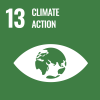Martina
At first glance, one notices rows of bamboo held together with a piece of black plastic sheeting on top. A closer look reveals pieces of cloth, pots, and other items scattered within and around the bamboo structure. Suddenly, you realize - this is actually their home.
This is how our team met Martina Dayacos by chance after going down a slim dirt road that branches off the highway in Barangay Virginia, Sto. Niño, Cagayan Valley, in the northeastern part of Luzon, in the Philippines.

“I live here with my daughter and grandchildren. Since I’m old, I mostly stay here at home and help take care of the baby while my daughter goes to the next town where she works as a manicurist. It has been very difficult for us living here. We’ve never had a proper home because we can barely get by.”
Martina shared that as Typhoon Mangkhut landed, the barangay (town) leaders were already telling people to evacuate their homes.
“As you can see, the structure is not that stable. We just felt our house shaking from the wind. That’s when we knew we had to leave.”

The family returned to find the plastic sheet they used as a roof blown away. Thankfully, the structure did not collapse but Martina knows it is still not a safe place to live in. Her hope of a better home for her daughter and grandchildren was finally fulfilled when the family was chosen to be one of the beneficiaries of the transitional shelters during IOM’s Typhoon Mangkhut response.
“This new home means so much to us. It does not compare to simply receiving money that we would eventually spend to feed ourselves. As I am growing older and weaker, I cannot contribute much to make my family’s life better, but now we can finally say that we have a home and a safe place to sleep.”
Martina wishes to farm the land surrounding their new home in the future. She says this could open more sustainable livelihood options for her and her family.

Joey
A group of people gather beside a house heavily damaged by the typhoon. They begin constructing a new foundation for what would be Joey’s new home.
Joey Butay from Barangay Masikal, Sto. Niño sits together with his wife, Daisy, and daughter, Mary Joy, who has special needs. They tearily recall the events before the storm arrived.
“All I could do is fold our clothes and we had to leave. There was not much we could do,” says Daisy. “When we returned, there was no roof. There were no walls. I can recall the sadness I felt when I saw it.”
Joey and his family stayed in an evacuation center for two days before returning to their home to witness the damage brought by the storm. However, the destruction of their home also brought out the spirit of bayanihan (helping one’s neighbour) in their community.

“Members of the community suddenly came together to help me put up a small hut where we could temporarily stay. It made me feel so grateful to see all these people help my family.”
Through the help of the town leader, Joey and his family were chosen as one of the beneficiaries of a transitional shelter. Both him and his wife could not contain their happiness when they found out.
“I can’t thank everyone enough for all the help we have received. I can only wish that my children can grow up well in our new home.”

Jordan
A two hour car ride, a boat ride across the river, and an hour’s walk across vast corn fields - this is what it takes to reach Barangay Balanni, Sto. Niño. The small town has been identified as Geographically Isolated and Disadvantaged Area (GIDA) and is home to 25 indigenous families who have been displaced by Mangkhut.
“We were not prepared when the storm arrived. Our roof, made out of black plastic sheeting, was immediately blown away by the strong winds, leaving me and my family soaked in the rain,” Jordan Bukig recalls.
However, the typhoon was not the only cause of displacement for these families. Their homes were also unfortunately caught in the crossfire between armed groups, leaving bullet holes in their walls.
“We had to come down from the mountains where our homes were since it was no longer safe. We were just so lucky that the barangay (town) leader was so helpful and generous. He made it his mission to find us a new place to stay.

His family together with several others have now settled on a piece of land. The landowner agreed to sell it to them through staggered payments. It is here where five new transitional shelters have been constructed for them. Their new homes are also near local schools where they can learn to be literate while still being able to preserve their customs and traditions.
“Balanni is now our new home. This is our chance to live our lives and continue our livelihood in a safer place. We’re all here together and we cannot be thankful enough.”
IOM RESPONSE
The province of Cagayan Valley in Northern Luzon has the second highest number of people affected by Typhoon Manghut (locally named Ompong) last September 2018. The International Organization for Migration (IOM), with funding from the European Union Civil Protection and Humanitarian Aid (ECHO), provided transitional and recovery shelter solutions to over 1,700 families who no longer had a safe home.
After being unable to identify construction sites cleared as safe by the Mines and Geosciences Bureau (MGB) and the Municipal Social Welfare and Development (MSWD) offices in Benguet, IOM has identified four barangays in Sto. Niño, Cagayan Valley with a need for temporary shelters for vulnerable households with totally destroyed homes. 60 transitional shelters were built and handed over to those most affected.





